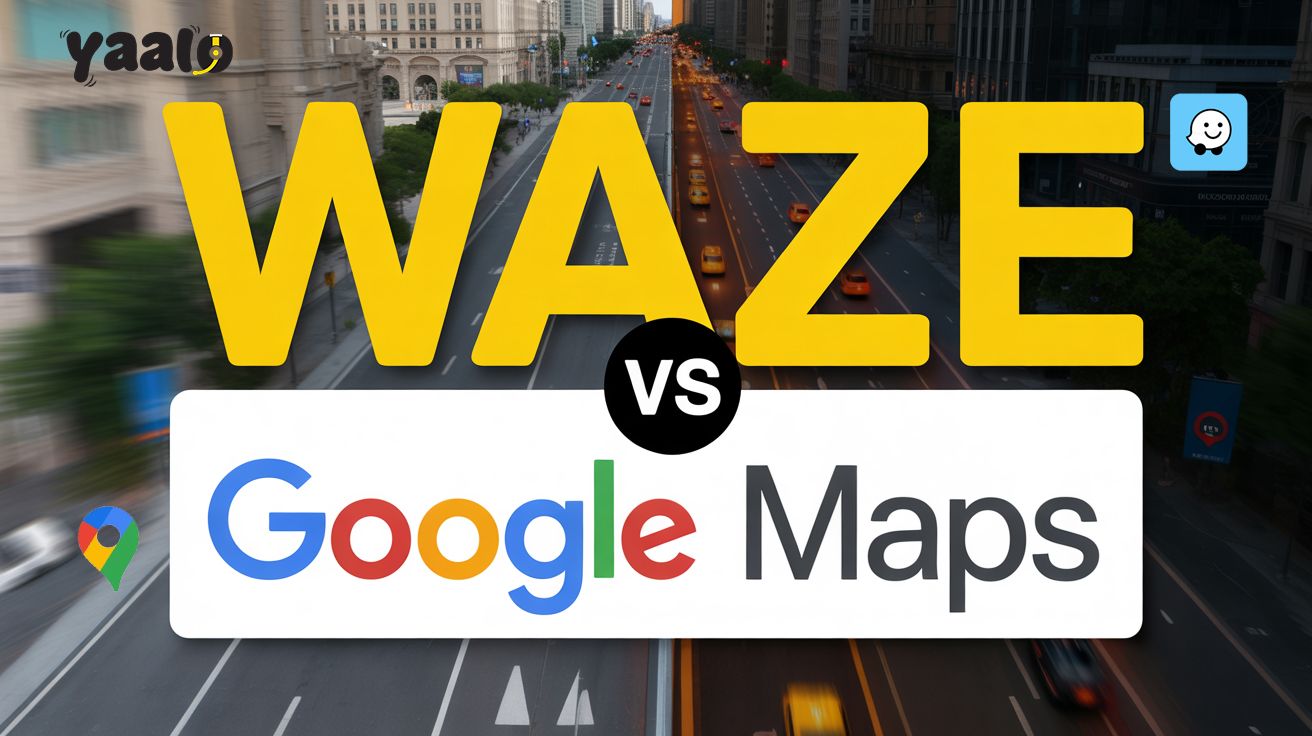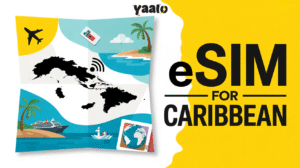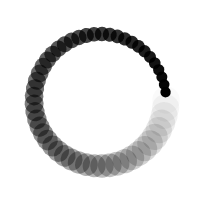You’ve just touched down in a brand-new country. Your eSIM connects without a hitch, and within seconds, you’ve got full access to maps, messages, and everything else you need.
But as you roll your suitcase out of the airport and into the chaos of unfamiliar streets, one question instantly pops into your head: Should you trust Waze or Google Maps to get you where you’re going?
It’s not a small decision. For international travellers, your navigation app isn’t just a tool; it’s a travel companion.
And if you’re counting on smooth, battery-friendly performance without chewing through data, choosing the best navigation app becomes more than just a preference; it’s a necessity.
So, which one’s got your back in 2025? Let’s find out!
1. Waze vs Google Maps: A Real-World Look at What Makes Them Different
Before you pick a navigation app for your trip, it helps to know what each one is really built for. While Waze and Google Maps both fall under Google’s umbrella, they serve different needs, and knowing the difference can genuinely make travel easier.
Waze is designed with drivers in mind. It’s fast, responsive, and powered by its users. When someone spots a traffic jam, accident, or police checkpoint, they report it in the app, and that info helps others reroute in real-time.
If you’re behind the wheel in a busy city or trying to avoid getting stuck during rush hour, Waze works like a local guide, whispering updates as they happen.
Google Maps, on the other hand, is more of an all-rounder. It’s great whether you’re walking, taking a train, riding a bike, or driving. It shows you how to get from A to B, sure—but it also helps you explore. Want to know where the nearest café is, how late the train runs, or what a place looks like from the street? Google Maps can show you all that in one go.
Both apps are reliable, but the best one for you depends on your plans.

2. How It Feels to Use Waze vs Google Maps: Interface and Experience That Matter When You’re Abroad
Let’s face it—when you’re in a new country with unfamiliar roads and limited time, the last thing you want is to fumble through a confusing app. The way a navigation app presents information makes all the difference, especially when you’re depending on your phone and an eSIM connection to get around.
Waze brings a unique personality to your driving experience. It’s colorful, lively, and feels like you’re part of a local driving club. You’ll see pop-up icons for road hazards, fellow drivers sending alerts, and a lot of real-time chatter from the road. Some love this level of interactivity—it makes the app feel alive. But for first-time users or anyone who prefers a cleaner interface, Waze can come off as visually noisy and even a bit overwhelming.
Google Maps, on the other hand, is all about simplicity and structure. It’s built to support different travel needs—whether you’re walking, catching a train, or driving across town. Its layout is clean straightforward, and gives you just enough detail without the extra flair. You can search a location, check business hours, and switch between travel modes without missing a beat.
For travelers using eSIMs, both apps have their merits. If you’re behind the wheel and want updates from people just like you navigating the same roads, Waze adds value. But if you’re juggling public transport schedules or hopping between sights on foot, Google Maps is a calmer, more reliable choice that does a bit of everything—without draining your data or battery life.
3. Real-Time Traffic & Navigation Accuracy: Who Gets You There Smarter?
When you’re navigating in a foreign city, every wrong turn costs you more than just time—it can mean missed check-ins, higher cab fares, or unnecessary stress. That’s why accuracy and real-time updates aren’t just “nice to have”—they’re essential.
Waze is fast on its feet, thanks to its driver-first approach. Every user becomes a live traffic reporter. If there’s an accident, a traffic jam, or even a pothole ahead, chances are you’ll get the heads-up in real-time. The app immediately reacts, rerouting you around trouble before you even see the brake lights. It’s made for people who hate delays and want the fastest way out of traffic—especially helpful when you’re driving in a city you’ve never been to.
Google Maps takes a more calculated approach. It mixes real-time data with years of traffic patterns and machine learning to decide the best route. It might not reroute you as quickly as Waze, but the detours it offers are often more balanced, especially in busy cities where “faster” doesn’t always mean “better.” It also accounts for public transport delays and estimated arrival times with surprising accuracy.
If you’re using Yaalo eSIM to stay connected abroad, your choice depends on how you travel. Waze is ideal if you’re driving and want to actively avoid headaches. But if you’re planning a day that involves buses, walking or a bit of both, Google Maps gives you a broader, smoother view of the journey ahead—without eating through your data too quickly.
4. Offline Access and Data Usage: A Big Deal for eSIM Travelers
When you’re exploring a new country with just an eSIM to stay connected, how much data your app uses—and whether it works offline—can make a big difference.
Google Maps has the upper hand here. It lets you download entire areas—cities, regions, even countries—so you can navigate without using mobile data. That’s a huge help if you’re heading somewhere with a weak signal or trying to stretch your eSIM data abroad. Once saved, you can still search for locations, get turn-by-turn directions, and even find nearby places—all without being online.
Waze, on the other hand, doesn’t offer true offline functionality. While it may cache parts of your route if you start with a strong connection, the app needs a live data link to give you traffic updates, reroute you, or show road alerts. That’s not ideal if you’re in a rural area or your eSIM plan has a tight data limit.
5. App Integration: Music for the Drive vs. Seamless Trip Planning
When you’re on the road—especially in a new country—how your navigation app connects with other services can either simplify your day or leave you juggling between screens.
Waze focuses on what drivers care about most: keeping their eyes on the road and hands on the wheel. It pairs effortlessly with popular audio apps like Spotify and YouTube Music so that you can control your playlist or podcast directly within the navigation screen. That’s a nice bonus for long drives or traffic-heavy routes where switching apps isn’t safe—or convenient.
Google Maps, however, takes integration a step further. Since it’s built into the broader Google ecosystem, it connects with Gmail, Google Calendar, Contacts, and even Google Travel. Booked a hotel or flight? It automatically pops up in your suggested destinations. Need to find your Airbnb or catch a connecting train? It’s already in your route, without you needing to search for it again.
For travelers using an eSIM to manage their entire trip from their phone, this kind of automatic syncing can save time, data, and stress. If you’re looking for smart coordination between your travel plans and your maps app, Google Maps makes everything feel seamless—before you even ask.
6. Privacy and Data Security: What You Need to Know Before You Share Your Location
When you’re traveling—especially with an eSIM keeping you connected abroad—your location data becomes a digital breadcrumb trail. That’s why it’s important to know how these apps handle your personal information.
Google Maps is more open about the data it collects. You get access to features like Incognito Mode, detailed location history settings, and personalized privacy controls.
Waze, by comparison, doesn’t go quite as deep into the details, but it also collects less data overall. Since it’s more focused on live driving conditions, it gathers just enough information to provide accurate, real-time traffic updates. That said, both apps fall under Google’s broader privacy umbrella, so the general policies apply to each.
7. Battery Consumption and App Performance
Waze is a battery drainer. Its constant recalculations and background updates, while useful, can wear down your phone fast—especially if you’re running music and the app simultaneously.
Google Maps is better optimized for battery life, with smarter caching and a more balanced performance. For long travel days, especially with eSIM use, this makes a noticeable difference.
8. Travel Scenarios: Which App Fits Best?
- City Driving: Waze wins with its real-time detours and traffic alerts.
- Walking Tours: Google Maps offers detailed pedestrian routes and even indoor maps.
- Public Transport: Google Maps includes bus, metro, and train schedules.
- Road Trips: Waze’s community alerts shine on the highway.
- International Travel: Google Maps is the safer bet with offline functionality and rich location data.
9. For eSIM Users: Choosing the App That Matches Your Connectivity
eSIM travelers are always conscious of the following:
- Data usage
- Connectivity reliability
- Battery life
Google Maps addresses all three better than Waze. Its offline maps reduce data dependency. Its performance is smoother in low-signal areas. And it’s generally lighter on the battery.
That said, Waze is ideal if you’ll be driving in highly populated areas and need instant traffic updates—provided your eSIM plan gives you sufficient data.
Conclusion
If you’re navigating a new city on foot, using public transport, or want the most flexibility while preserving data, Google Maps is your best travel companion.
If you’re on a road trip, driving through traffic-heavy zones, and want a hyper-responsive app with community features, Waze will get you there faster.
No matter which app you choose, pairing it with a reliable eSIM from Yaalo ensures you’re never out of touch, no matter where the road takes you.
Stay connected. Stay in control. Travel smart with Yaalo eSIM.
FAQs
Does Waze work without the internet or offline?
No, Waze needs an internet connection to update routes and traffic alerts. It may cache some data, but it’s not reliable for offline use.
Which app uses more mobile data—Waze or Google Maps?
Waze generally uses more data due to real-time traffic updates, while Google Maps lets you download maps and use navigation offline, saving eSIM data.
Can I use Google Maps or Waze with an eSIM while travelling?
Yes! Both apps work seamlessly with eSIMs. Google Maps is more data-efficient, making it ideal for travellers managing limited eSIM plans.
Is Waze more accurate than Google Maps in traffic?
Waze is faster in reporting live traffic and road hazards through user input, but Google Maps offers more balanced, multi-modal routes and reliability.









